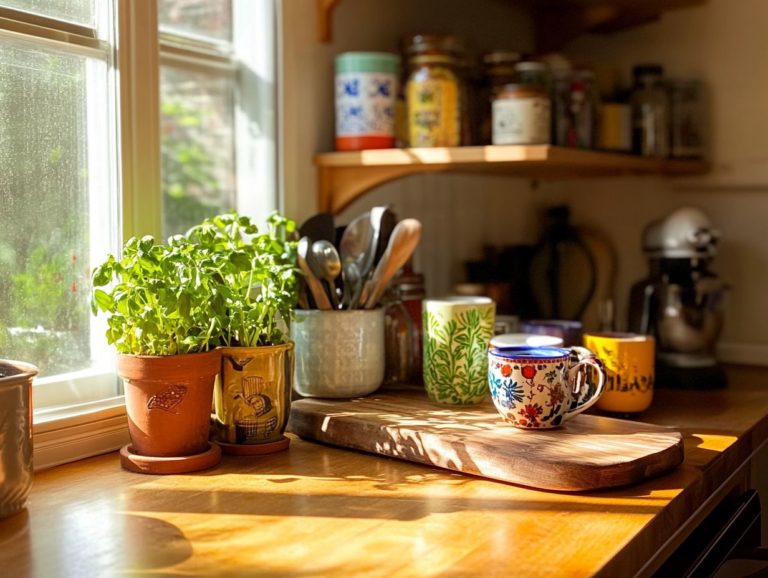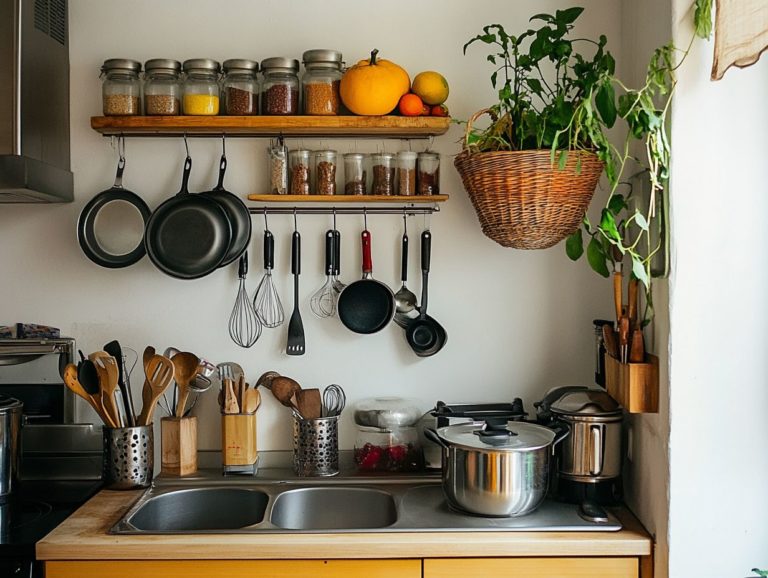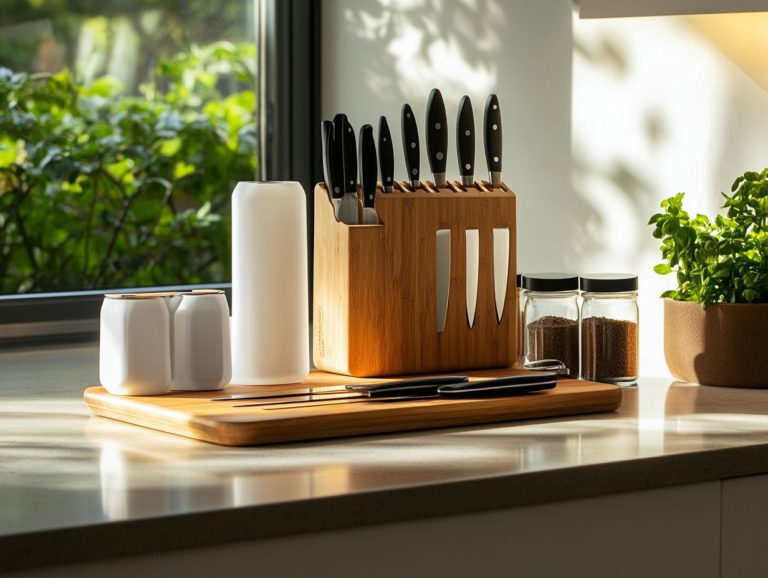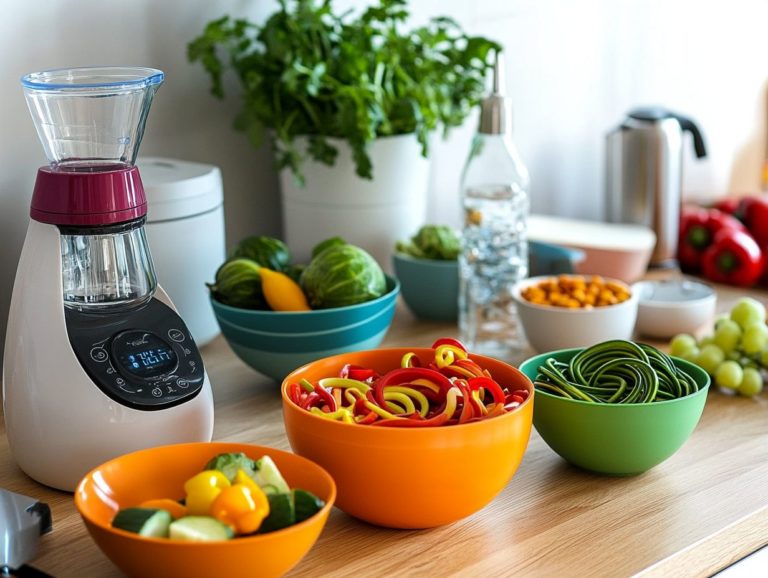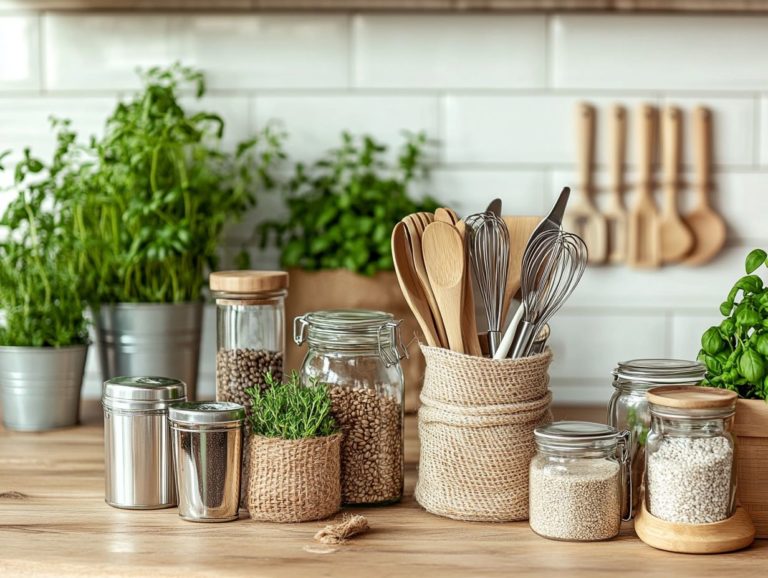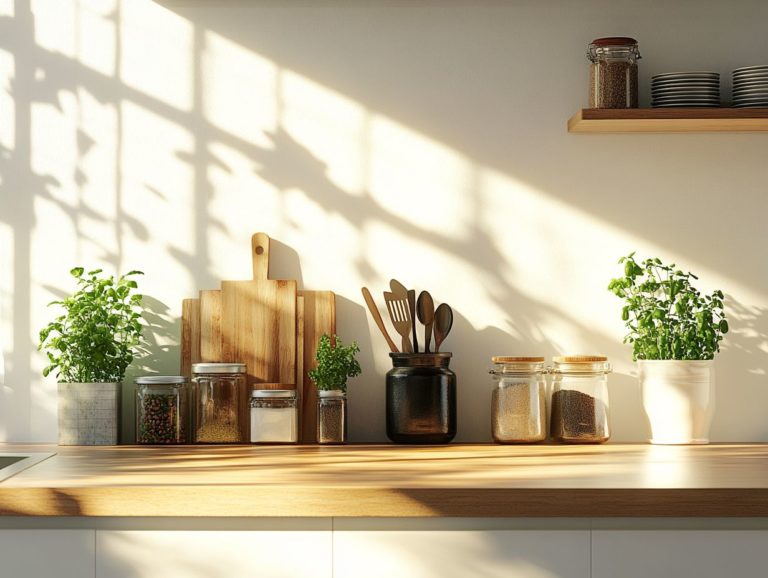The History of Kitchen Accessories: A Brief Overview
The kitchen has always been the heart of your home, evolving alongside culture and technology.
From the rudimentary tools of your ancestors to today s sleek, high-tech gadgets, kitchen accessories have undergone a remarkable transformation over time.
This journey of kitchen tools begins with early inventions, sweeps through the mass production era of the Industrial Revolution, and showcases modern innovations that redefine cooking.
Cultural influences play a pivotal role in shaping kitchen accessories, celebrating both timeless classics and trendy designs that catch your eye.
Join in as you trace this captivating evolution and uncover what makes these tools essential for your culinary adventures.
Contents
- Key Takeaways:
- The Evolution of Kitchen Accessories
- Innovations in Kitchen Accessories
- The Influence of Culture and Cuisine
- Popular Kitchen Accessories Throughout History
- Frequently Asked Questions
- What are kitchen accessories?
- When did kitchen accessories first come into use?
- How did kitchen accessories evolve over time?
- What are some examples of popular kitchen accessories throughout history?
- How have kitchen accessories impacted cooking and dining?
- Are there any interesting facts about the history of kitchen accessories?
Key Takeaways:
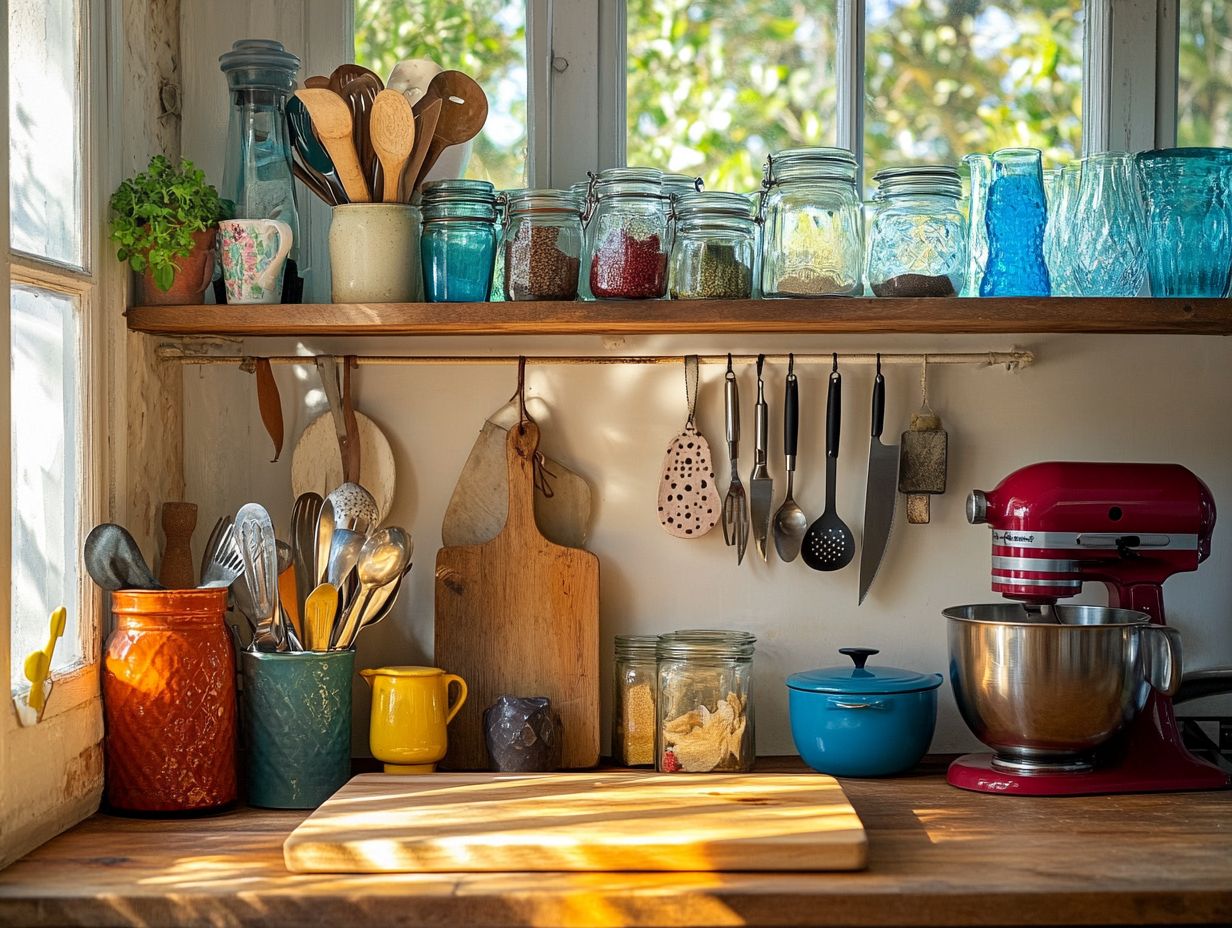
- Discover the rich history of kitchen accessories, from early tools and gadgets to modern innovations, through the lens of cultural influences and evolving culinary traditions.
- See how the Industrial Revolution changed everything, making cooking far more accessible with standardized tools.
- Explore significant milestones and designs that have shaped kitchen accessories today, enhancing our cooking and dining experiences!
The Evolution of Kitchen Accessories
The evolution of kitchen accessories is a captivating journey that mirrors advancements in cooking technology, materials, and new cooking ideas that have transformed food preparation over the centuries, highlighting the role of kitchen accessories in culinary creativity.
From the simplest utensils of early cooking to specialized tools designed for specific tasks think chef’s knife and egg separator each development has significantly boosted efficiency in the kitchen.
By exploring this evolution, you gain valuable insights into how materials like copper, stainless steel, and earthenware have been skillfully employed to cater to the needs of both professional chefs and home cooks.
Early Kitchen Tools and Gadgets
Early kitchen tools and gadgets established the groundwork for modern culinary practices, employing simple materials and designs to streamline essential cooking tasks.
Imagine the journey from the humble stone knife to the more refined iron utensils. These early implements were pivotal in shaping the culinary landscape you navigate today. Handcrafted wooden spoons and rudimentary forks provided you with the means to mix, serve, and savor your meals.
Specialized tools like mortars and pestles gave you the power to grind and blend ingredients with finesse.
The shift from natural materials such as bone and wood to metals marked a significant leap in cooking techniques, allowing for more intricate preparation methods like chopping, slicing, and mashing.
This evolution not only intensified flavors but also ignited creativity in the kitchen, paving the way for culinary innovations you continue to enjoy.
Industrial Revolution and Mass Production
The Industrial Revolution was a pivotal moment in the realm of kitchen accessories, ushering in an era of mass production and groundbreaking kitchen equipment that transformed cooking technology.
This shift enabled the creation of standardized tools, making cooking far more accessible for the average household. The introduction of cast iron skillets, enameled pots, and mechanical gadgets made food preparation faster. Families could spend less time cooking.
As factories ramped up the mass production of items like blenders and can openers, these utensils evolved into more ergonomic and user-friendly designs, appealing to a wider audience. (Ergonomic means designed to be comfortable and efficient.)
In turn, these advancements gave you the power to explore an array of cuisines, enhancing the culinary experience in households around the world.
Innovations in Kitchen Accessories
Innovations in kitchen accessories have revolutionized your approach to food preparation, presenting you with modern materials and designs that elevate both efficiency and safety in the kitchen.
Modern Materials and Designs
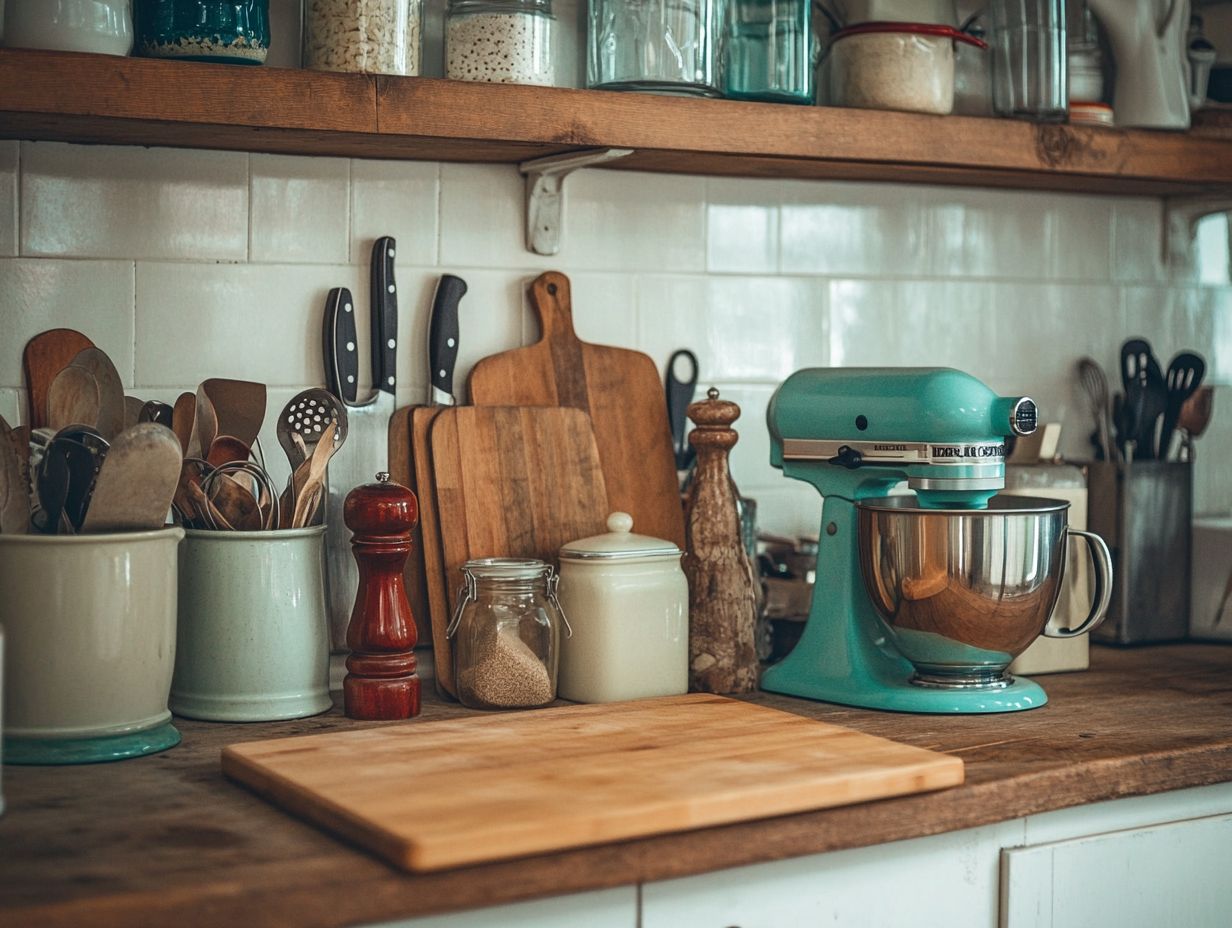
Modern materials have profoundly reshaped the design and functionality of kitchen utensils. Stainless steel, glass, and plastic have emerged as essential elements in contemporary cooking.
Stainless steel stands out for its exceptional durability. Its resistance to rust and corrosion makes it an ideal choice for items like mixing bowls and measuring cups that must withstand the rigors of daily use.
Meanwhile, glass utensils are not only visually appealing but also non-reactive, ensuring that the flavors of your ingredients remain pure. You’ll find mixing bowls and storage containers made of glass to be particularly popular for these reasons.
Plastic utensils, in contrast, offer remarkable versatility and are incredibly easy to clean. Measuring spoons and spatulas made from plastic are often preferred for their lightweight nature, making them a practical addition to any kitchen.
Each material brings its own unique advantages to food preparation, catering to a variety of culinary needs and elevating your cooking experience.
Technological Advancements
Technological advancements have transformed kitchen equipment, bringing forth electric ovens, gas stoves, and a myriad of innovations that simplify your cooking experience.
These developments have boosted your cooking efficiency and opened up a realm of cooking options. For instance, convection ovens use circulating hot air to cook food evenly and swiftly, dramatically cutting down your preparation time.
Electric appliances, from blenders to multi-cookers, play a vital role in simplifying complex recipes, giving the power to both novice and seasoned chefs like you to experiment with confidence.
This shift in cooking methods has sparked a wave of creativity in your kitchen, enabling you to prepare intricate dishes with relative ease. The energy efficiency of modern equipment also contributes to sustainable cooking practices, reflecting your growing awareness of environmental concerns.
The Influence of Culture and Cuisine
Culture and cuisine have a fascinating impact on kitchen accessories! Have you ever wondered how local traditions shape the tools we use in the kitchen?
The influence of culture and cuisine on kitchen accessories is truly profound. As you explore various regions, you’ll notice how local traditions and culinary practices intricately shape the tools and utensils used for food preparation.
Each item tells a story, reflecting the unique flavors and techniques that define a particular culture’s approach to cooking.
Regional Variations and Cultural Traditions
Regional variations and cultural traditions offer remarkable insights into the diverse array of kitchen utensils and specialized tools that elevate your food preparation practices.
Take the Mediterranean, for example. The mortar and pestle, or ‘mortaio,’ is more than just a grinding tool; it embodies communal cooking rituals. In India, the ‘tawa’ a flat, circular griddle holds significant importance in crafting staple flatbreads like roti, fostering a sense of togetherness as families engage in shared meal preparation.
Each of these utensils stands out not just for its design and functionality but also for its significance in culinary heritage, shaping local cooking techniques and flavor profiles.
The way you wield these tools can reveal much about a region’s history, available resources, and culinary practices.
Impact on Kitchen Accessories
The impact of culture on kitchen accessories is strikingly apparent in their craftsmanship, usage, and the way they are cherished through generations, all while reflecting the culinary heritage of diverse cuisines.
Consider the intricate designs of Moroccan tagines or the elegantly carved wooden spoons that grace Scandinavian kitchens; each piece tells a story waiting to be discovered today!
In Japan, sushi knives are revered not just as tools but as an extension of a chef’s artistry, exemplifying a flawless fusion of form and function.
Similarly, the traditional French concept of mise en place the practice of having everything in its place before you start cooking underscores the importance of organization and preparation, leading to specific utensils that embody this philosophy.
These examples reveal that kitchen accessories transcend mere functionality; they serve as a bridge between the past and present, inviting you to engage with a rich tapestry of cultural narratives.
Popular Kitchen Accessories Throughout History
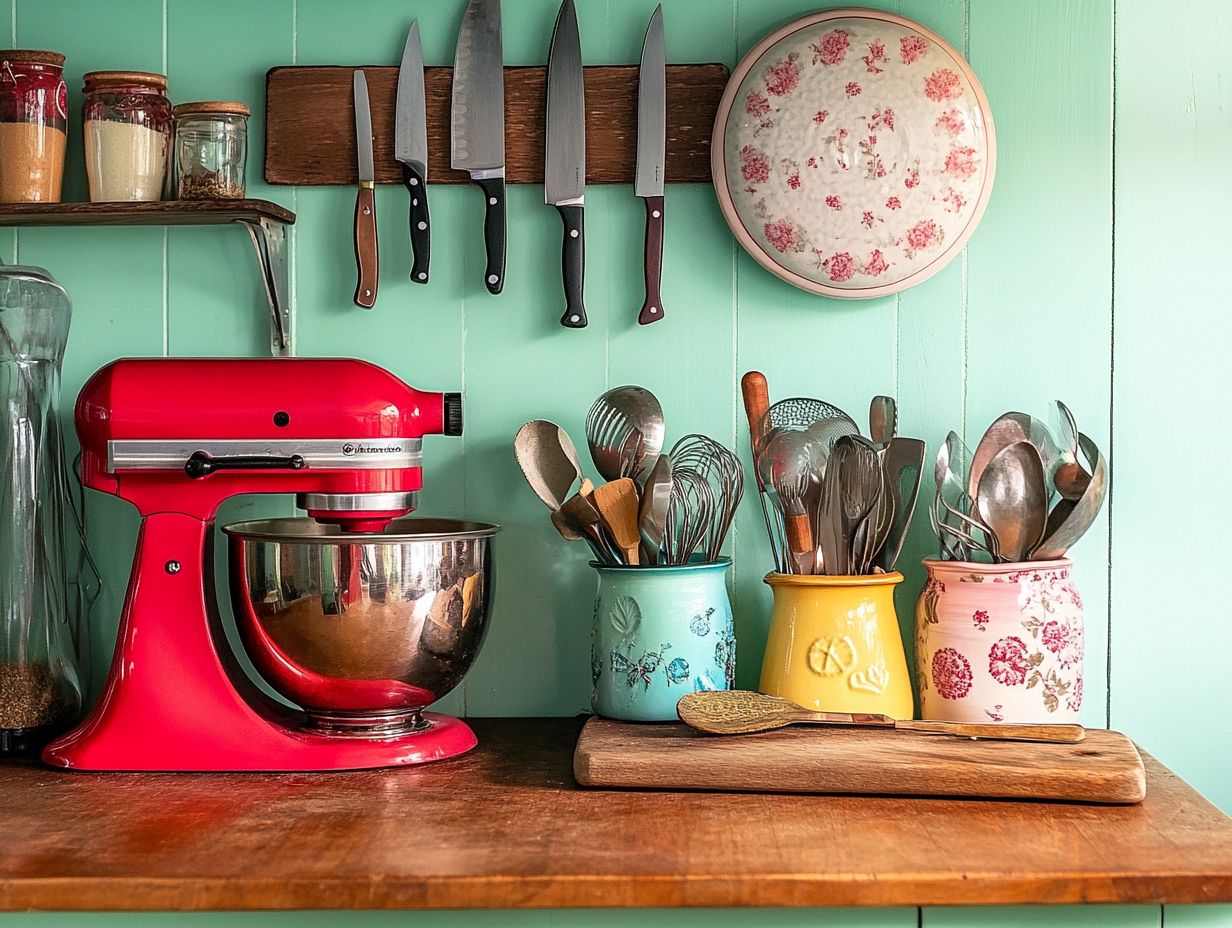
Popular kitchen accessories throughout history have not only shaped culinary practices but have also highlighted the key features of kitchen accessories that showcase the evolution of innovation and design within your kitchen space.
Timeless Classics and Trendy Innovations
Timeless classics include the chef’s knife and egg separator. These remain essential kitchen tools.
Trendy innovations infuse new functionalities and designs into your food preparation routine.
These staples embody practicality that transcends generations, proving their worth in any culinary setting. While you can always rely on these enduring tools for simplicity and reliability, modern cooking technology introduces eye-catching gadgets like multi-functional food processors and precision cookers. Each promises efficiency with sleek designs.
However, it’s important to remember that these modern innovations often require some practice to use effectively, which can overshadow the straightforward utility of traditional utensils.
Ultimately, the blend of classic and contemporary tools invites you to curate a kitchen that showcases both enduring values and evolving techniques.
Significant Milestones and Designs
Significant milestones in the development of kitchen accessories reveal the creativity and ingenuity that drive their design and functionality, ultimately leading to culinary innovations that elevate your food preparation experience.
Consider the invention of the knife in ancient times. This groundbreaking tool revolutionized the way you cut and prepare food.
Then there s non-stick cookware, which has transformed cooking and cleaning.
The introduction of electric appliances like blenders and food processors has taken cooking to the next level, making complex techniques accessible to you, the home cook.
Each of these innovations reshapes modern cooking practices, allowing you to achieve greater efficiency and unleash your creativity in the kitchen.
Ergonomic designs enhance usability while prioritizing comfort and safety, reflecting a profound understanding of the intricacies of the cooking process itself.
Frequently Asked Questions
What are kitchen accessories?
Curious about kitchen accessories? They re the tools and gadgets that make cooking and dining a joy!
When did kitchen accessories first come into use?
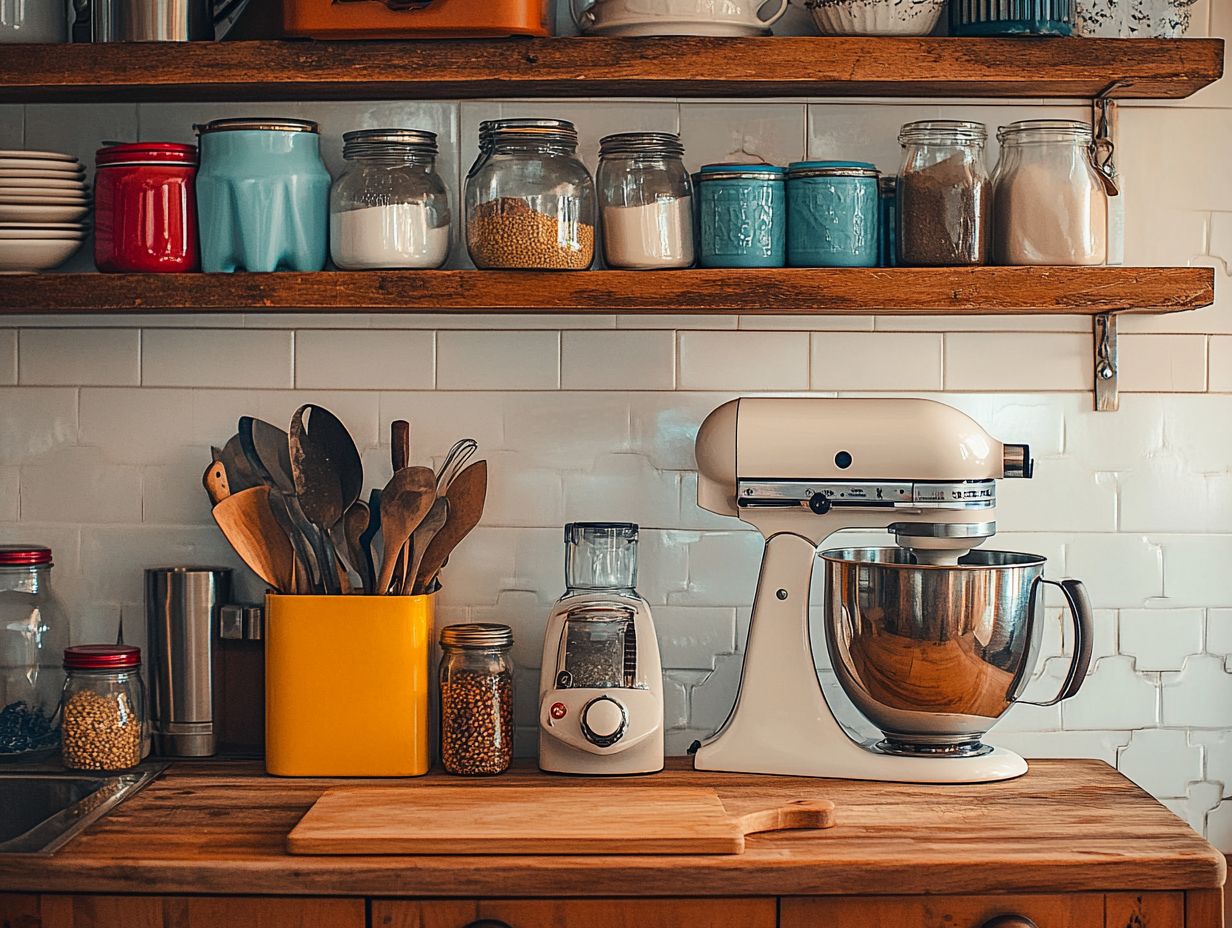
The use of kitchen accessories can be traced back to ancient civilizations such as the Egyptians, Greeks, and Romans, who utilized tools like knives and spatulas for cooking and serving food.
How did kitchen accessories evolve over time?
In the Middle Ages, kitchen accessories became more specialized and diverse due to advancements in technology and the rise of the middle class. In the 19th and 20th centuries, mass production and industrialization led to an even wider variety of kitchen accessories available to the average household.
What are some examples of popular kitchen accessories throughout history?
Some popular kitchen accessories throughout history include pots and pans, knives, spoons, forks, cutting boards, and serving dishes. More modern examples include blenders, food processors, and other electric appliances.
How have kitchen accessories impacted cooking and dining?
Kitchen accessories have made cooking and dining easier and more efficient. They have also allowed for more creativity and variety in meals, as different tools serve different purposes in food preparation and presentation.
Are there any interesting facts about the history of kitchen accessories?
One interesting fact is that the first cookbook was written in the 1st century by the Roman gourmet, Apicius, and contained recipes that used various kitchen accessories. Another interesting fact is that the first known kitchen utensil was a simple flint knife used by early humans for cooking and eating.

